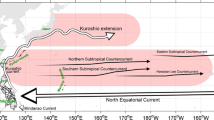Abstract
Trajectories of mesoscale eddies in the Kuroshio recirculation region were investigated by using sea surface height (SSH) anomaly observed by the TOPEX/POSEIDON and ERS altimeters. Cyclonic and anticyclonic eddies have been traced on maps of the filtered SSH anomaly fields composed from the altimeter observations every ten days. Both the cyclonic and anticyclonic eddies propagate westward in the Kuroshio recirculation region from a region south of the Kuroshio Extension. The propagation speed of these eddies has been estimated as about 7 cm s−1, which is much faster than the phase speed theoretically estimated for the baroclinic first-mode Rossby wave in the study area. It was also found that in the Izu-Ogasawara Ridge region, most of eddies pass through the gap between the Hachijojima Island and Ogasawara (Bonin) Islands, and some of the eddies decay around the Izu-Ogasawara Ridge. It seems that the trajectory of the eddies is crucially affected by the bottom topography. In the region south of Shikoku and east of Kyushu, some of the eddies coalesce with the Kuroshio. It is also suggested that this coalescence may trigger the path variation of the Kuroshio in the sea south of Japan.
Similar content being viewed by others
References
Aoki, S. and S. Imawaki (1996): Eddy activities of the surface layer in the western North Pacific detected by satellite altimeter and radiometer. J. Oceanogr., 52, 457–474.
Aoki, S., S. Imawaki and K. Ichikawa (1995): Baroclinic disturbances propagating westward in the Kuroshio Extension region as seen by a satellite altimeter and radiometers. J. Geophys. Res., 100, 839–855.
AVISO/Altimetry (1996): AVISO User handbook for Sea Level Anomaly altimeter products (edition 2.0), AVI-NT-011-312-CN, CLS Space Oceanography Division, Toulouse, France.
Cheney, R. E. (1977): Synoptic observations of the oceanic frontal system east of Japan. J. Geophys. Res., 82, 5459–5468.
Cheney, R. E., P. L. Richardson and K. Nagasaka (1980): Tracking a Kuroshio cold ring with a free-drifting surface buoy. Deep-Sea Res., 27, 641–654.
Cornillon, P., D. Evans and W. Large (1986): Warm outbreaks of the Gulf Stream into Sargasso Sea. J. Geophys. Res., 91, 6583–6596.
Ebuchi, N. and K. Hanawa (1995): Comparison of surface current variations observed by TOPEX altimeter with TOLEX-ADCP data. J. Oceanogr., 51, 351–362.
Ebuchi, N. and K. Hanawa (2000): Mesoscale eddies observed by TOLEX-ADCP and TOPEX/POSEIDON altimeter in the Kuroshio Recirculation region south of Japan. J. Oceanogr., 56, 43–57.
Hydrographic Department of the Japanese Maritime Safety Agency (1995): Prompt Report on Oceanographic Condition, Nos. 2–13.
Ichikawa, K. (2001): Variation of the Kuroshio in the Tokara Strait induced by meso-scale eddies. J. Oceanogr., 57, 55–68.
Ichikawa, K. and S. Imawaki (1994): Life history of a cyclonic ring detached from the Kuroshio Extension as seen by the Geosat altimeter. J. Geophys. Res., 99, 15,953–15,966.
Kawai, H. (1972): Hydrography of the Kuroshio Extension. p. 235–352. In Kuroshio; Its Physical Aspects, ed. by H. Stommel and K. Yoshida, Univ. Tokyo. Press, Tokyo, Japan.
Kawai, H. (1980): Rings south of the Kuroshio and their possible roles in transport of the intermediate salinity minimum and in formation of the skipjack and albacore fishing grounds. p. 250–273. In The Kuroshio IV: Proc. 4th CSK Symp., Tokyo, Japan, Feb. 1979.
Kawamura, H., Y. Sawa and F. Sakaida (1995): Satellite observations of 3–6 months variation in the Kuroshio and the Subtropical front. Umi to Sora, 71, 9–15 (in Japanese with English abstract).
Kitano, K. (1975): Some properties of the warm eddies generated in the confluence zone of the Kuroshio and Oyashio Currents. J. Phys. Oceanogr., 5, 245–252.
Kobashi, F. and H. Kawamura (2001): Variations of sea surface heights with a period of 3–7 months in the subtropical gyre of the North Pacific. J. Geophys. Res. (submitted).
Kuragano, T. and M. Kamachi (2000): Global statistical spacetime scales of oceanic variability estimated from the TOPEX/POSEIDON altimeter data. J. Geophys. Res., 105, 955–974.
Kuragano, T. and A. Shibata (1997): Sea surface dynamic height of the Pacific Ocean derived from TOPEX/POSEIDON altimeter data: Calculation method and accuracy. J. Oceanogr., 53, 585–599.
Le Traon, P. Y. and F. Ogor (1998): ERS-1/2 orbit improvement using TOPEX/POSEIDON: The 2 cm challenge. J. Geophys. Res., 103, 8045–8057.
Le Traon, P. Y., P. Gaspar, F. Bouyssel and H. Makhmara (1995): Using TOPEX/POSEIDON data to enhance ERS-1 data. J. Atmos. Ocean. Tech., 12, 161–170.
Le Traon, P. Y., F. Nadal and N. Ducet (1998): An improved mapping method of multi-satellite altimeter data. J. Atmos. Ocean. Tech., 25, 522–534.
Mizuno, K. and W. B. White (1983): Annual and interannual variability in the Kuroshio current system. J. Phys. Oceanogr., 13, 1847–1867.
Qiu, B., K. A. Kelly and T. M. Joyce (1991): Mean flow and variability in the Kuroshio Extension from Geosat altimetry data. J. Geophys. Res., 96, 18,491–18,507.
Suga, T. and K. Hanawa (1995): The Subtropical Mode Water circulation in the North Pacific. J. Phys. Oceanogr., 25, 958–970.
Tai, C. K. and W. B. White (1990): Eddy variability in the Kuroshio Extension as revealed by Geosat altimetry; Energy propagation away form the jet, Reynolds stress, and seasonal cycle. J. Phys. Oceanogr., 20, 1761–1777.
Toba, Y., H. Kawamura, K. Hanawa, H. Otobe and K. Taira (1991): Outbreak of warm water from the Kuroshio south of Japan—A combined analysis of satellite and OMLET oceanographic data—. J. Oceanogr. Soc. Japan, 47, 293–303.
Yasuda, I., K. Okuda and M. Hirai (1992): Evolution of a Kuroshio warm-core ring: Variability of the hydrographic structure. Deep-Sea Res., 39,Suppl. 1, S131–S161.
Yoshikawa, Y., M.-S. Kim and H. Mitsudera (1998): Mesoscale eddies and the Kuroshio current observed by TOPEX/POSEIDON altimetric data. JAMSTECR, 33, JAMSTEC, Yokosuka, Japan, 135–141 (in Japanese with English abstract).
Author information
Authors and Affiliations
Rights and permissions
About this article
Cite this article
Ebuchi, N., Hanawa, K. Trajectory of Mesoscale Eddies in the Kuroshio Recirculation Region. Journal of Oceanography 57, 471–480 (2001). https://doi.org/10.1023/A:1021293822277
Issue Date:
DOI: https://doi.org/10.1023/A:1021293822277



